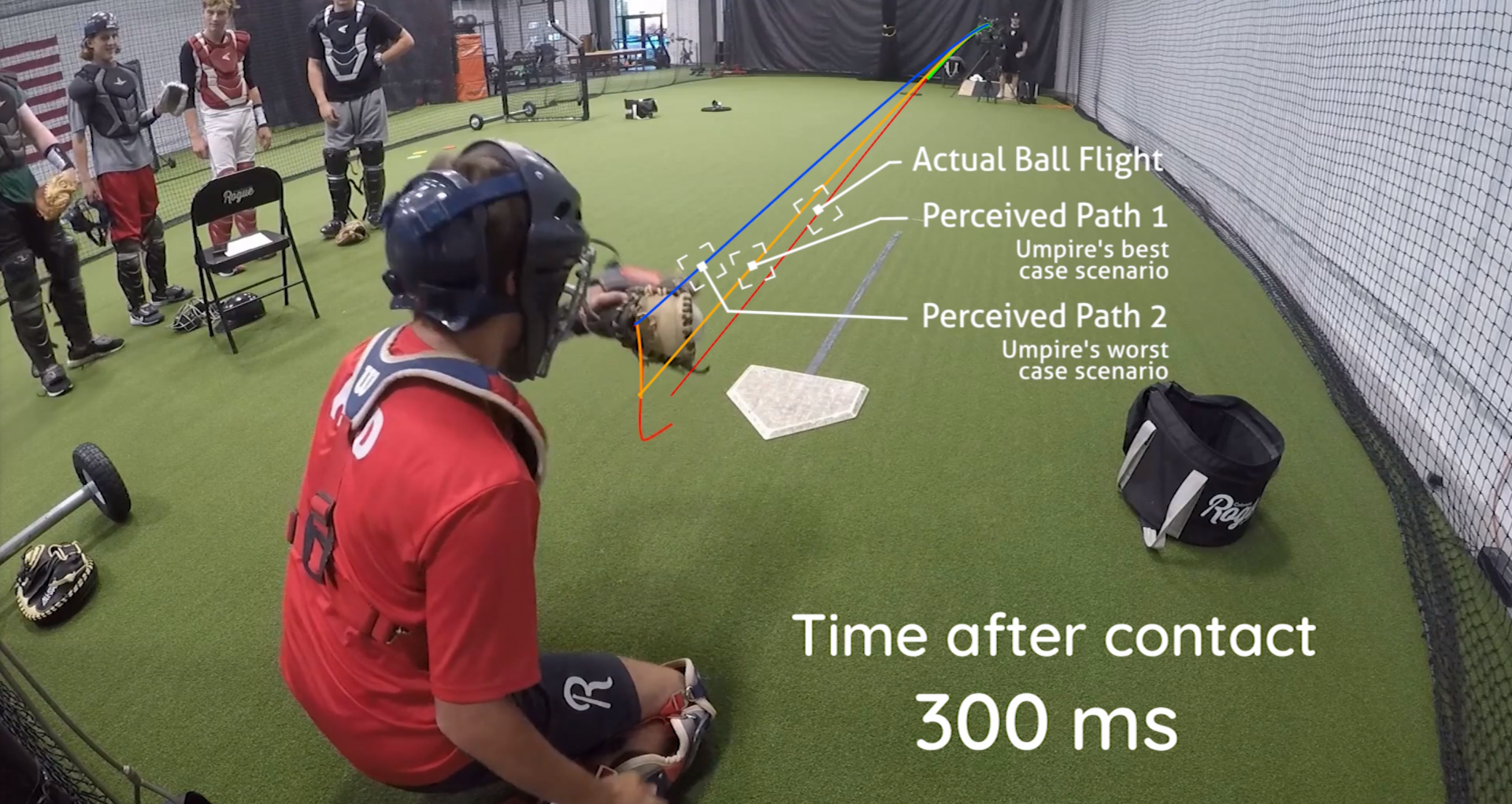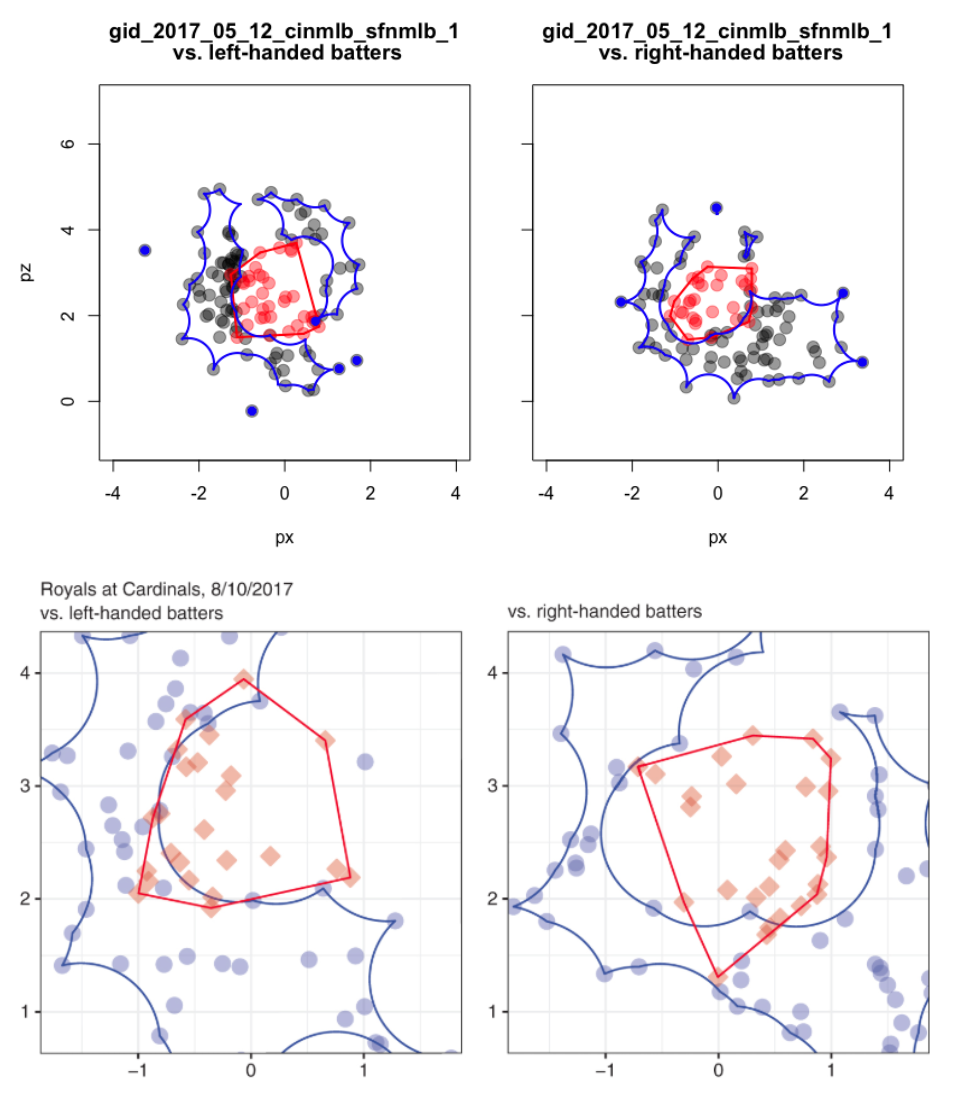Want more great
Catching Content?
Sign up for FREE and see everything we have to offer!
Like most guys my age, I was always taught growing up that manipulating the pitch as a catcher was a bad thing. That the umpire would be able to see the catcher moving the ball, and would refuse to give him a strike as a result. I never really challenged this way of thinking until recently. It just made sense to me. We were trying to build a relationship with the guy behind us, and being honest with our pitch presentation was a way to do that.
So, when catchers started manipulating pitches and it was working, I was as surprised as anybody. This went against everything I thought I knew about how umpires perceive pitches and render a ball/strike decision. Now, if there’s one thing you need to know about me, it’s that I HATE not understanding something! And if I was going to teach these new techniques to catchers, I better understand what was going on.
I set out trying to answer these 3 questions:
- Why is glove manipulation getting more borderline strike calls?
- What role does the catch, and post-catch glove movement play in the umpire’s perception?
- What are the key aspects of the catch that lead to more strike calls?
The Deception Window Theory
This theory of the Deception Window suggests that there is a period of time before, during, and after the catch where the umpire is not receiving visual information of the ball/glove. Ball manipulation by the catcher occurring during this window will alter the umpire’s perceived flight path of the baseball.

The window of time between when the catcher first contacts the ball and when the umpire first sees the glove, I call ‘The Deception Window’. In theory, this window should vary between 67 milliseconds and 373 milliseconds (depending on the umpire and pitch location/velocity/movement).
Developing the Theory
When we talk about anything relating to balls and strikes, we have to look at the umpire. He is the sole person responsible for judging where the ball crosses the plate and deciding if it falls within the rulebook definition of the strike zone. So, if ball manipulation by the catcher is getting more borderline strike calls (and the numbers say it is), then it has to be affecting either the umpire’s perception of the pitch or his decision making process.
Can an Umpire Determine Pitch Location from Ball Flight Alone?
I think the general assumption is that umpires can track the entire flight of a pitch, and make a strike/ball decision solely on that information. But if that were true, then how the catcher receives and presents the pitch should have no significant effect on the call.
Thanks to the massive amount of data the MLB collects, we know this isn’t true. How the catcher receives the pitch is clearly having some influence on the umpire. So what’s going on?
Well, it is likely that umpires (as well as the batter and catcher) don’t actually see the full flight of the pitch. In fact, it’s likely the umpire never actually sees the pitch cross the plate!
The Limits of Human Perception
There are physical limitations on how fast our eyes can move. And when it comes to tracking a pitch in baseball, this limitation is exceeded almost every time!
What is this limitation? A study at the University of British Columbia found that their baseball players were able to use smooth eye tracking for objects traveling up to ~50 degrees of visual angle per second. For our purposes, we will assume that a major league umpire’s dynamic visual acuity is similar to that of a college baseball player and he has the same limitations. What does this look like from the umpire’s point of view? Check this out…
Watching this, you’ll notice a couple things:
It stands to reason, that the more ball flight the umpire is able to see, the more accurate his estimation of where the ball crossed the plate will be. If this is true, we would expect that an umpire’s zone is most consistent up-in, and least consistent low-away.
- You’re still able to determine a rough idea of where the ball is going to end up even without seeing the full pitch flight. Your brain is able to estimate the missing information. For most pitches, this is sufficient information to decide whether it’s a ball or strike. But for pitches near the edges of the zone, where 1 inch can be the difference between a ball or strike, you’re probably gonna need some more information to be confident in your decision.
- Pitches closer to the umpire’s eyes (up and in) can be tracked longer than pitches further from his eyes (down and away). This makes sense because a pitch arriving down and away will require larger eye movements to track it, than a pitch coming straight at the umpire’s face.
It stands to reason, that the more ball flight the umpire is able to see, the more accurate his estimation of where the ball crossed the plate will be. If this is true, we would expect that an umpire’s zone is most consistent up-in, and least consistent low-away.

I wasn’t able to find a lot of publicly available umpire consistency maps, but for the 2 games shown above, this appears to be happening. Two games is not even close to a large enough sample size, so if any of you have access to more of these consistency charts, I’d love to chat!
The Limits of Human Perception
If the umpire is getting limited ball flight information on pitches low or outside, what other information can he use to better determine where the pitch crossed the plate?
The catcher’s glove.
The human brain is an amazing thing. Even with partial ball flight information, if the umpire can determine where the ball ended up, his brain can connect the dots to determine a more accurate flight path of the pitch. So the next question becomes, when does the umpire see the glove?
After the eyes lose smooth pursuit eye tracking (>50deg visual angle per second), they switch to fast catch-up saccades (rapid jumps between 2 fixed positions). This saccade movement takes about 205 milliseconds to occur (for reference, blinking your eye takes between 100-400ms). As long as the umpire is trying to track the pitch for as long as possible, the pitch will cross the plate, the initial catch happens, and a portion of the glove movement after the catch happens all before the umpire’s eyes move to the glove.
This means that not only can the umpire not see the pitch cross the plate or the initial catch, but that there is a window of time the catcher is able to move the glove after the catch without the umpire being able to see the movement. This window of time is what I refer to as the deception window.
What Does This Mean for Training Catchers?
If this deception window exists, then maximizing the amount of glove movement back to the strike zone during the deception window should be a key factor in getting more strike calls. I would expect receptions with a high GPE (glove path efficiency) and a high average glove velocity in the 100ms after the catch should have a higher strike probability.
Both GPE and glove velocity are measurable results that can be used when training catchers.
Supporting Research
Brandon Oliver (catchingcoalition.com) completed a brief study on this by tracking the eye movement of 4 umpires. The umpires were instructed to call balls and strikes and give feedback to the hitter on the location of pitches. They were not told that their eye movements were being evaluated. All pitches were low in the zone, and the umpires knew what pitch was coming.
Video analysis showed that on 92% of the pitches the umpires' eyes did not move towards the catcher’s glove until 90-160ms after the catch occurred, and 83% of the pitches fell within 130-160ms after the catch.
While this is only one brief study, it does seem to indicate that there is a window of time between when the catcher contacts the baseball, and when the umpire can see the glove.
Clarifications and Sources
This is currently just a working theory and definitely needs some further research to validate it. It would be interesting to compare major league catcher’s GPE and glove velocity on shadow zone pitches to their strike rates and a deeper dive into umpire consistency charts would certainly shed some light on where their perceptual skills start to falter.
Smooth Pursuit Eye Tracking
The limit of tracking ability was set at 50 degrees of visual angle per second. This was based on the findings of a Dynamic Visual Acuity study on collegiate baseball players by the University of British Columbia. Age and training appear to affect this ability. Therefore, each umpire will be unique in when they lose smooth eye pursuit while tracking a pitch.
Source: http://www.80percentmental.com/blog/2017/2/20/how-our-eyes-actually-track-a-fastball
Reacquiring the ball with saccade movements
In all pitches tested, the span of 1 saccade movement (after the pitch exceeds 50 deg/s) is insufficient to reacquire the ball prior to it reaching the catcher’s glove.
- 205ms was used as the expected latency for an exogenous saccade movement. Source: https://www.ncbi.nlm.nih.gov/pmc/articles/PMC5014680/
- Peak angular velocity of the eye was calculated using the following linear formula: v=94+27.6*A
Where v = peak angular velocity in deg/s
A = amplitude of movement in degrees
Source: https://en.wikipedia.org/wiki/Saccade#/media/File:Saccadic_main_sequence.svg
- In all cases, the saccade movement could be completed within 1 video frame. Latency appears to be the limiting factor.
Calculating the deception window
- In calculating the duration of the deception window, it was not possible to anticipate how many saccade movements would be necessary to reacquire the ball/glove.
- The deception window duration for a single saccade movement (from point of lost tracking to glove position) ranged from 67ms to 167ms
- The deception window duration of two saccade movements (from point of lost tracking to anticipated location to actual location) ranged from 273ms to 373ms
- A median range of 133ms to 300ms was used in the visual demonstration.
Want more great
Catching Content?
Sign up for FREE and see everything we have to offer!


